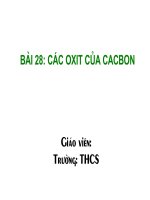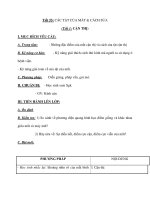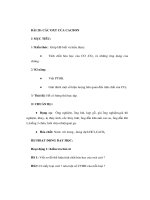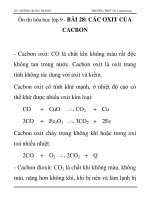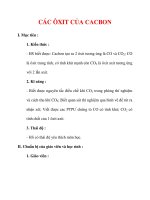Tiết 36. Các oxit của cacbon
Bạn đang xem bản rút gọn của tài liệu. Xem và tải ngay bản đầy đủ của tài liệu tại đây (57.9 KB, 14 trang )
<span class='text_page_counter'>(1)</span><div class='page_container' data-page=1></div>
<span class='text_page_counter'>(2)</span><div class='page_container' data-page=2>
<b>Néi dung bµi häc</b>
<sub> I. Cacbon oxit.</sub>
</div>
<span class='text_page_counter'>(3)</span><div class='page_container' data-page=3>
I. Cacbon oxit
<sub> C«ng thøc ph©n tư: CO</sub>
</div>
<span class='text_page_counter'>(4)</span><div class='page_container' data-page=4>
I. Cacbon oxit
1. TÝnh chÊt vật lí
<sub> Là chất khí không màu, không mùi.</sub>
<sub> í</sub>
<sub>t tan trong n ớc, hơi nhẹ hơn không khí </sub>
</div>
<span class='text_page_counter'>(5)</span><div class='page_container' data-page=5>
I. Cacbon oxit
2. TÝnh chÊt ho¸ häc
<b> a. CO lµ oxit trung tÝnh</b>
</div>
<span class='text_page_counter'>(6)</span><div class='page_container' data-page=6>
I. Cacbon oxit
2. TÝnh chÊt ho¸ häc
<b> a. CO lµ chÊt khư</b>
ở<sub> nhiệt độ cao, CO khử đ ợc nhiều oxit nhiều kim </sub>
lo¹i.
VD:
CO(k) + CuO(r) CO2(k) + Cu(r)
đen đỏ
4CO(k) + Fe3O4(r) 4CO2(k) + 3Fe(r)
to
</div>
<span class='text_page_counter'>(7)</span><div class='page_container' data-page=7>
I. Cacbon oxit
2. TÝnh chất hoá học
<b> a. CO là chất khử</b>
CO cháy trong oxi hoặc không khí:
</div>
<span class='text_page_counter'>(8)</span><div class='page_container' data-page=8>
I. Cacbon oxit
3.
ứ
<sub>ng dụng</sub>
<sub>CO đ ợc dùng làm nhiên liệu, chất khử</sub>
<sub>CO còn đ ợc dùng làm nguyên liệu trong công </sub>
</div>
<span class='text_page_counter'>(9)</span><div class='page_container' data-page=9>
II. Cacbon đioxit
<sub>Công thức phân tử: CO</sub>
<sub>2</sub></div>
<span class='text_page_counter'>(10)</span><div class='page_container' data-page=10>
II. Cacbon Đioxit
1. Tính chất vật lí
<sub>Là khí không màu, nặng hơn không khÝ </sub>
(dCO2/kk=44/29).
<sub>Ng êi ta cã thÓ rãt CO</sub><sub>2</sub><sub> tõ cốc này sang cốc </sub>
khác.
</div>
<span class='text_page_counter'>(11)</span><div class='page_container' data-page=11>
II. Cacbon Đioxit
2. TÝnh chÊt ho¸ häc
<b>a. T¸c dơng víi n íc</b>
CO2(k) + H2O(l) H2CO3(dd)
Quú tÝm chuyÓn sang
màu hồng nhạt
</div>
<span class='text_page_counter'>(12)</span><div class='page_container' data-page=12>
II. Cacbon Đioxit
2. Tính chất hoá học
<b>b. Tác dụng với dung dịch bazơ</b>
CO2 + kiÒm muèi + n íc
<b>VD: </b>
CO2(k) + 2NaOH(l) Na2CO3(dd) + H2O(l)
CO2(k) + NaOH(l) NaHCO3(dd)
1 mol 2 mol
</div>
<span class='text_page_counter'>(13)</span><div class='page_container' data-page=13>
II. Cacbon §ioxit
KÕt luËn:
CO
<sub>2</sub>là 1 oxit axit, có những
tính chất của oxit axit.
</div>
<span class='text_page_counter'>(14)</span><div class='page_container' data-page=14>
II. Cacbon Đioxit
3. ứng dụng
<sub> Chữa cháy, bảo quản thực phẩm.</sub>
<sub> Pha chế n ớc giải khát cã ga, s¶n xuÊt </sub>
</div>
<!--links-->
